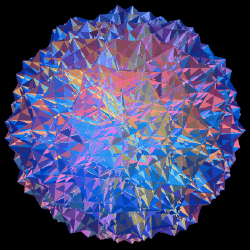An Invisible Dimension

Science fiction characters make travel through extra dimensions look as easy as getting on the subway, but physicists have never taken them seriously. Now in the 6 December PRL a team proposes a radical idea: We may indeed live in a world with more than three spatially infinite dimensions, yet the extra dimensions might be essentially imperceptible. For years researchers have discussed extra dimensions that might be “compactified”–curled up to a very small size–but no one thought that non-compact dimensions could exist without obvious effects on experiments.
Many physicists hope that string theory will ultimately unify quantum mechanics, the theory of small-scale interactions, with general relativity, the theory of gravity. String theory requires at least nine spatial dimensions, so proponents normally claim that all but three of them are compactified and only accessible in extremely high-energy particle collisions. As an alternative to compactified dimensions, Lisa Randall of Princeton University and Raman Sundrum, now of Stanford University, describe a scenario in which an extra, infinite dimension could have remained undetected so far.
Other researchers have pointed out that if extra dimensions exist, the strong, weak, and electromagnetic forces and their associated particles might operate within a three-dimensional “subspace” of the higher dimensional world. Like beads on a wire that lies on a table, the particles would be restricted to their own set of dimensions, unable to move beyond them. But gravity is different: It consists of the motions of spacetime, which includes all dimensions simultaneously. So Randall and Sundrum imagine a world with four spatial dimensions, where gravity exists in all four, but the other forces–and all of our direct experience–exist in 3D. They say we live in a “3-brane” located at some specific position along the fourth spatial dimension.
Solving Einstein’s general relativity equations for this arrangement, the team found that gravity would not have the same strength everywhere in the Universe. The carriers of the gravitational force known as gravitons would be restricted in the extra dimension, and could only rarely stray from the neighborhood near our 3-brane, making gravity weaker far away. But the more important result is that–according to Randall and Sundrum’s derivations–experiments in our 3-brane would agree very closely with Newton’s law of gravity because the gravitons we observe would have little experience of the extra dimension. Observing the effects of such an extra dimension would be difficult, Randall explains, but she and her colleagues are still hoping to come up with a way to look for it. “The surprising thing is how well this theory evades experimental detection,” she says.
The paper “really changed our perspective,” says Mark Wise, of the California Institute of Technology in Pasadena, speaking for himself and many theoretical physicists he knows. If there were an infinite extra dimension, he and his colleagues thought it would be obvious from experiments, so they were surprised by the result. “It’s a very clever idea,” he says and adds that it’s so simple he wonders why he didn’t come up with it first.
More Information
Paper by the same authors:Phys. Rev. Lett. 83, 3370 (25 October 1999)


